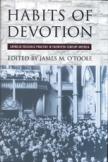How We Express Faith
At the Church of Saint Ignatius Loyola on Park Avenue in Manhattan between mid-summer of 1896 and June of the following year, the seven Jesuit priests who resided there heard nearly 80,000 confessions, all but 2,000 of them particular - that is, listing the penitents’ sins since their last confessions. In the days when spiritual health was equated with the frequency and number of penitents, Father Patrick Healy would have added up the numbers, brought forward the sum each week and added up his annual score, based on the fiscal calendar. In Boston, the Rev. James A. Walsh, who later founded Maryknoll, sat in the confessional as a young curate in Roxbury four to five hours on a Saturday, sometimes until 9:30 at night, and his experience was typical.
These, as James M. O’Toole remarks in the introduction to Habits of Devotion, were among the unremarkable routines through which American Catholics lived out their faith for generations.
This important study focuses on religious practice in the mid-20th century (mid-1920’s to mid-1970’s), the decades before and after the pivotal Second Vatican Council. The essays in the book look at religious historical periods in terms of before-and-after, and do it very well. Catholic historians want to claim a usable past so that contemporary believers may ground their religious identity in living traditions.
Confession is one of four practices of ordinary Catholics explored in Habits of Devotion, the others being prayer, Communion and Marian devotion. The book is a long-view historical study written by four leading Catholic scholars and drawn from a rich array of private diaries and archival records kept by priests in New York, Boston, Milwaukee and other major Catholic strongholds where the Irish, German and Italians practiced their faith. The Boston College historian James O’Toole, editor of the book and author of the chapter on confessional practices, is also the author of Passing for White: Race, Religion, and the Healy Family 1820-1920, and two other books.
As many readers know, the Second Vatican Council changed the practices of ordinary Catholics. Yet the nuances of those changes are illustrated by the findings here: confession changed abruptly and radically, in response to the psychologizing of religion and the idea of social sin over individual sin. Postconciliar changes in the sanctuary affected not only the posture but the attitudes of Catholics as they receive Communion. But of all the practices discussed in the book, Marian devotions have been the most mediated, or culturally framed.
Individual and collective prayer changed, in complex and subtle ways, but at a far slower pace than all other devotional habits. Prayer and Communion may have been the practices most insulated from, though not impervious to, broader cultural forces. But Marian devotions, along with expressions of guilt, may have been the most vulnerable to political and socio-cultural tides. The scholars offer a wealth of well-presented data, and readers may argue or debate these conclusions.
Joseph Chinnici, O.F.M., presents an extensive examination of prayer, the practice upon which all others are based. He examines the changes in devotional and paraliturgical practices, such as novenas and Benediction, and the pedagogy of participation that emerged from the council, and concludes that these led to a deepening commitment to a life of prayer. His chapter is balanced by the last, written by Margaret McGuiness, on the practice of devotion to the Eucharist, the object and subject of the Catholic faith. As Catholics went to confession less frequently, they went more often to Communion. Older forms of devotion were replaced by a more participatory attitude among the faithful, resulting in a profound reformulation by Catholics of the meaning of their religion. And that will take more time to measure.
A study of Marian devotion, written by Paula Kane, is similarly suggestive of the religious roots of the popular media culture. The figure of Mary, more than any other, has been adapted by all cultures for often conflicting political and cultural purposes. Kane describes prototypes of practices, within an economic, cultural and socio-political framework, for how Catholics used Mary as a boundary between themselves and Protestants, the Fatima cult as a cold war weapon against the Communists, and Mary the virgin as a feminine symbol of moral purity. After 1970, Marian media practices begun in the 1950’s, including the use of television, radio, theme parks, motion pictures and magazines, established a precedent for religion expressed through media in American popular culture, evident today on hundreds of Internet sites devoted to Mary.
Kane’s findings about Mary in the media support the theoretical concerns of many scholars who examine how media and religious practices intersect to form collective or cultural identity. Kane studies the cultural and political uses of Marian devotion, a folk habit strongly influenced by the clergy. This idea, advanced by the sociologist Rodney Stark and others, suggests that the success of religion is based on the principle that sacrifice creates the perception of value, and that when the costs of belonging diminish, so does religion’s strength.
Habits of Devotion is the second installment in a series edited by R. Scott Appleby from the Cushwa Center for the Study of Catholicism at the University of Notre Dame. Once Catholicism may have been examined by historians because of their idiosyncratic interests; now the need is to understand how religion is lived by ordinary believers. O’Toole and Appleby chose depth over breadth in designing this study. In doing so, they have reclaimed a usable past and produced a most readable and interesting book.
This article also appeared in print, under the headline “How We Express Faith,” in the March 7, 2005, issue.








